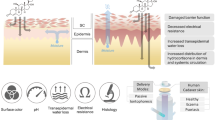Abstract
Percutaneous absorption of hydrocortisone was measured in six healthy adult men from whom informed consent had been obtained. The study compared a single topical dose to multiple-topical dose treatments (one vs three applications) on the same day. 14C-Labeled hydrocortisone in acetone was applied to 2.5 cm2 of ventral forearm skin and protected with a nonocclusive polypropylene chamber. The amount of 14C measured in urine collected over 7 days was used to determine hydrocortisone absorption. The treatments, performed 2 to 3 weeks apart, each utilized adjacent sites on the same individuals. A single dose of 13.33 µg/cm2 delivered 0.056 µg/cm2 of hydro-cortisone through the skin. When the single dose was tripled to 40 µg/cm2, the amount delivered through the skin increased by nearly three times, from 0.056 to 0.140 µg/cm2; the expected delivery was 3 x 0.056 µg/cm2 = 0.168 µg/cm2. Three serial doses of 13.33 µg/ cm2 (total, 40 µg/cm2) were also expected to deliver 0.168 µg/cm2 with or without soap and water washing between doses, but the observed amount of hydrocortisone delivered through the skin significantly exceeded our expectations. This indicates that multiple-dosing treatments resulted in a significant increase in bioavailability. It is postulated that increased vehicle application and washing dissolved and mobilized previously dosed hydrocortisone and increased bioavailability.
Similar content being viewed by others
REFERENCES
R. C. Wester, P. K. Noonan, and H. I. Maibach. Percutaneous absorption of hydrocortisone increases significantly with long term administration: In vivo studies in the rhesus monkey. Arch. Dermatol. 116:186–188 (1980).
R. C. Wester, P. K. Noonan, and H. I. Maibach. Frequency of application on percutaneous absorption of hydrocortisone. Arch. Dermatol. 113:620–622 (1977).
D. A. W. Bucks, H. I. Maibach, and R. H. Guy. Percutaneous absorption of steroids: Effect of repeated application. J. Pharm. Sci. 74(12): 1337–1339 (1985).
D. A. W. Bucks, H. I. Maibach, and R. H. Guy. Mass balance and dose accountability in percutaneous absorption studies: Development of a nonocclusive application system. Pharm. Res. 5:313–315 (1988).
R. C. Wester and H. I. Maibach. Relationship of topical dose and percutaneous absorption in rhesus monkey and man. J. Invest. Dermatol. 67:518–520 (1976).
R. C. Wester and H. I. Maibach. Rhesus monkey as an animal model for percutaneous absorption. In H. Maibach (ed.), Animal Models in Dermatology, Churchill Livingstone, London and New York, 1975, pp. 133–137.
R. C. Wester and H. I. Maibach. In H. Maibach and B. Bronaugh (eds.), Percutaneous Absorption, Marcell Dekker, New York, 1985, pp. 327–333.
Author information
Authors and Affiliations
Rights and permissions
About this article
Cite this article
Melendres, J.L., Bucks, D.A.W., Camel, E. et al. In Vivo Percutaneous Absorption of Hydrocortisone: Multiple-Application Dosing in Man. Pharm Res 9, 1164–1167 (1992). https://doi.org/10.1023/A:1015899721493
Issue Date:
DOI: https://doi.org/10.1023/A:1015899721493




